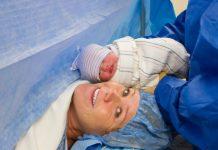This is the final post in a three part series. For more on Harrison’s story, see Navigating Epilepsy Part 1: Searching for a Diagnosis and Navigating Epilepsy Part 2: Living with Daily Seizures.
At this point in our journey, Harrison was having hundreds of seizures each day. He had progressed from the few slight random body jerks (almost two years prior), to barely being able to sit up due to constant seizures.
Praying for Relief through Surgery
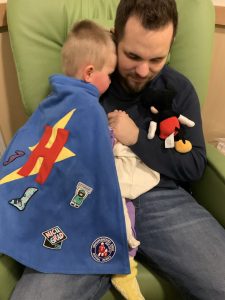 On the day of Harrison’s surgery, my husband and I were flooded with emotions. We kissed our sweet, smiley boy as he went into the operating room, waving to us over the nurse’s shoulder.
On the day of Harrison’s surgery, my husband and I were flooded with emotions. We kissed our sweet, smiley boy as he went into the operating room, waving to us over the nurse’s shoulder.
The corpus callosotomy was performed by laser, involving a two-inch incision on the top of his head. The surgeon was able to separate the left and right hemispheres of Harrison’s brain two-thirds of the way through. The goal was to eliminate the electric pulses of the seizure from crossing one side of the brain to the other.
Since Harrison has “Generalized Epilepsy” there’s no exact source of seizures, they fire randomly across his entire brain. Separating the hemispheres could help reduce the frequency and/or severity of the drop seizures by isolating them to one side.
The surgery went well. Then it was time to wait. We wouldn’t know the true effects of the surgery until Harrison recovered.
Post-Surgery 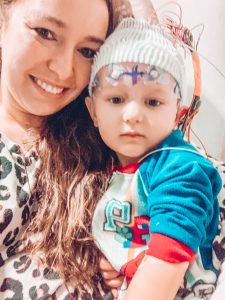
We visited Harrison in the recovery room about an hour later. I remember the relief I felt as his head turned toward our voices.
But then within five minutes of waking up, Harrison’s arm jerked upward suddenly.
A seizure.
My husband and I locked eyes, and we both broke down. Sobbing with defeat. Overflowing with emotions — frustration, despair, and anger.
Every hope we’d been clinging to came crashing down in one split second. The surgeon reassured us that Harrison’s brain had underwent a lot of trauma, and that we needed to give it time to heal. But our hope faded as he continued having seizures throughout his recovery.
Our amazing, tough boy was released a few days later. And it was hard to tell he had just underwent brain surgery. He was walking laps in the hospital, smiling and waving at nurses and fellow patients. We couldn’t see any immediate negative side effects from the surgery.
He continued to have seizures as he recovered, but the hundreds of daily twitches had stopped. And we focused on staying positive throughout the next few months of his recovery.

A Second (& Third) Opinion
About a month after surgery, we took Harrison to meet with a metabolic specialist at the Mayo Clinic.
I had previously been working with a functional medicine doctor in Colorado regarding holistic medicine treatments. Testing out a theory he had about mitochondrial dysfunction lowering the seizure threshold. I had heard of this doctor through an online Dravet forum. A mother in the group had shared her experience with the other parents. Other members had treated with the doctor as well, and had similar test results as her son.
I had Harrison tested and his results all came back normal. However, there were enough other symptoms that we decided to incorporate supplements. We hoped they would help heal the underlying metabolic issue and improve his seizure threshold.
Still Having Seizures
We noticed little improvements, but it didn’t reduce his overall daily seizure count. I reached out to Mayo to see if they had any additional insight or testing available, and they agreed to see Harrison.
Harrison, my mother and I met with a neurologist that was also a metabolic specialist. Before the appointment, Harrison had an EEG, MRI, and some bloodwork drawn. We then met with the neurologist, who listened to his history and suggested another test to see if he had a mitochondrial disorder. During the appointment, he had several seizures. After reviewing his EEG, history, and clear MRI, the neurologist recommended we see the head of the department and Dravet specialist the next day. We agreed to stay another night.
The next day we met with the Director of Pediatric Epilepsy, a woman whom I recognized from my research. I was very excited to have such a well-respected and knowledgeable doctor on Harrison’s team.
The Ketogenic Diet for Epilepsy
Our appointment was similar to the day before, reviewing history and test results. The metabolic testing came back negative, and there was still no answer for what was causing the seizures. We discussed medications to look into, but the first thing she suggested was trying the ketogenic diet.
We had briefly looked into the diet previously, but felt intimidated by how restrictive it was. With strict meals involving weighing every bite of food, frequent blood draws, and a hospital stay for the first week on the diet.
It didn’t seem like a viable solution before. But now we had one of the best child neurologists in the country saying she strongly believed in the diet and had seen great results.
We had to give it a try.
Food is Medicine
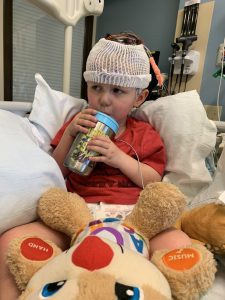
Many people don’t know that the ketogenic diet was actually first developed for people with Epilepsy.
Also, the medical ketogenic diet is quite different from the fad version recently adopted as a weight loss tool. There’s little room for error when using food as a medical treatment.
A dietician prepared Harrison’s meal plans to include an exact amount of calories, with a specific ratio of carbs and protein to fats. The ratio kept him in a steady level of ketosis throughout the day.
All food and liquid is weighed to the gram. And each gram needs to be consumed for every meal or snack (it’s as stressful and intimidating as it sounds, especially in the beginning).
Fortunately, the team at MN Children’s Hospital has a fantastic support system for families starting the diet. We checked into the hospital for a five to seven day stay while Harrison initiated the diet and his body transitioned into ketosis. Allowing for constant monitoring to ensure his body could get used to the drastic change in diet and wouldn’t go into acidosis (affecting liver function).
Trying the Modified Atkins Diet
Unfortunately, our in-patient stay was one month after our visit with Mayo. So with guidance from the team at MN Children’s, we started to “ease into” the diet at home by transitioning to the modified Atkins diet. This involved cutting down carbs, increasing fats, and limiting highly-processed foods.
I dove into research and found ideas for food and fats to help get into ketosis. We noticed some improvement on seizure activity after the first few days.
And the weekend before checking into the hospital he had two seizures in a 36-hour period.
This was the greatest day he’d had in years! We felt optimistic and excited to start the full diet.
Monday morning we checked in and Harrison was hooked up to an EEG for constant monitoring of his seizure activity. Then we met the dietician and learned how to choose and weigh the food.
Changing His Diet
It actually was less complicated than expected. They provided us with pre-made recipes and several meal and snack options. My mother and I took turns practicing: choosing a meal, weighing the food, and ensuring Harry ate every bite.
I also attended several hours of training with the dietician, and received a binder full of tips, instructions, and meal plans. On day two, they tested for ketones and found out Harrison was already producing ketones (probably sped up as a result of his modified Atkins diet — go mom!) and he’d been experiencing a moderate amount of seizures throughout the day. We were able to go home early, on day three, because he was producing ketones and we had a solid understanding of the diet.
In the next few months, we continued to strictly follow the diet. We noticed some improvements in seizure control and cognition. But we still hadn’t replicated those 36 hours with only two seizures.
Making Adjustments
We adjusted the ratio and amount of calories, trying to find success. Along with regular dietician appointments, we needed frequent blood draws to make sure Harrison’s body was functioning properly with the high-fat diet.
It turns out he is a ketone producing machine, and he created the “max” desired ketones at a very low ratio. He still was having 20-40 seizures a day, but we couldn’t increase his ratio without his body creeping dangerously close to acidosis. The team said he was “maxed out” on keto, so his doctor recommended a new medication instead.
We added yet another medicine, number 11 at this point, which we quickly determined was a failure to reduce seizure frequency.
I requested we try the modified Atkins diet again, to see if we could replicate that initial success. But that didn’t work. We went back to the low ratio of keto, and his neurologist then prescribed medication number 12.
Searching for Hope
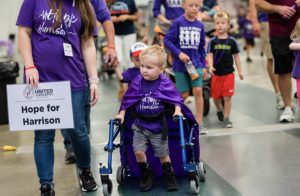
We now know food is medicine and the keto was helping his epilepsy at some point. I wasn’t ready to completely give up on this route and continue to blindly try the next new, even more potentially dangerous medication.
I looked back to my online forums of other parents, continuing my desperate search for things that worked for someone else that we could try.
We had already tried craniosaccral therapy, the chiropractor, detoxing, CBD oil, MCT oil, everything I could find that had shown success with others with Epilepsy. Clearly the medication route wasn’t working.
There had to be another way.
One day I discovered a study on a new diet therapy for pediatric epilepsy. After researching the diet and reading feedback from other parents, I reached out to see if Harrison could join.
He has been accepted into the study, and we are currently waiting to start the diet. And I am once again clinging to hope as we search for a way to help our boy.











